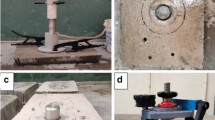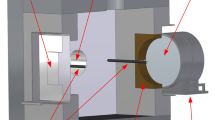Abstract
In order to know the advantages of using environmentally friendly materials in construction, namely, aggregates from tire recycling, this study aims to develop a numerical and mathematical model in order to analyze the thermal behavior of concrete on the basis of rubber aggregates as a function of time. The main goal of this paper is to look at how the heat shock temperature of 800 °C and the conditions of exposure to the ISO 834 standard fire affect the thermal behavior of concrete with different amounts of rubber (0%, 10%, 20%, and 30%) and constant humidity (3%). The results obtained show that for all mixtures, the temperature propagated in the sample decreases at different rates depending on the content of rubber aggregates. This reduction is mainly due to the decrease in the ability of the material to transfer heat and the increase in the thermal capacity that must be given to the material to increase its temperature. Statistics, frequency distributions, contours, and 3D views have all shown that the numerical model developed works. This makes the model an important tool and a good way to describe how concretes behave when heated.
























Similar content being viewed by others
References
Rahgozar MA, Saberian M. Geotechnical properties of peat soil stabilised with shredded waste tyre chips. Mires Peat. 2016;18:1–12. https://doi.org/10.19189/MaP.2015.OMB.205.
Saberian M, Mehrinejad Khotbehsara M, Jahandari S, Vali R, Li J. Experimental and phenomenological study of the effects of adding shredded tire chips on geotechnical properties of peat. Int J Geotech Eng. 2018;12:347–56. https://doi.org/10.1080/19386362.2016.1277829.
Li J, Saberian M, Nguyen BT. Effect of crumb rubber on the mechanical properties of crushed recycled pavement materials. J Environ Manag. 2018;218:291–9. https://doi.org/10.1016/j.jenvman.2018.04.062.
Turatsinze A, Garros M. On the modulus of elasticity and strain capacity of self-compacting concrete incorporating rubber aggregates. Resour Conserv Recycl. 2008;52:1209–15. https://doi.org/10.1016/j.resconrec.2008.06.012.
Grinys A, Sivilevičius H, Pupeikis D, Ivanauskas E. Fracture of concrete containing crumb rubber. J Civ Eng Manag. 2013;19:447–55. https://doi.org/10.3846/13923730.2013.782335.
Siddique R, Naik TR. Properties of concrete containing scrap-tire rubber—an overview. Waste Manag. 2004;24:563–9. https://doi.org/10.1016/j.wasman.2004.01.006.
Nematzadeh M, Shahmansouri AA, Fakoor M. Post-fire compressive strength of recycled PET aggregate concrete reinforced with steel fibers: optimization and prediction via RSM and GEP. Constr Build Mater. 2020;252:119057. https://doi.org/10.1016/j.conbuildmat.2020.119057.
Gesoglu M, Güneyisi E, Hansu O, İpek S, Asaad DS. Influence of waste rubber utilization on the fracture and steel–concrete bond strength properties of concrete. Constr Build Mater. 2015;101:1113–21. https://doi.org/10.1016/j.conbuildmat.2015.10.030.
Nematzadeh M, Mousavimehr M. Residual compressive stress-strain relationship for hybrid recycled PET–crumb rubber aggregate concrete after exposure to elevated temperatures. J Mater Civ Eng. 2019. https://doi.org/10.1061/(ASCE)MT.1943-5533.0002749.
Khaloo AR, Dehestani M, Rahmatabadi P. Mechanical properties of concrete containing a high volume of tire–rubber particles. Waste Manag. 2008;28:2472–82. https://doi.org/10.1016/j.wasman.2008.01.015.
Mousavimehr M, Nematzadeh M. Predicting post-fire behavior of crumb rubber aggregate concrete. Constr Build Mater. 2019;229:116834. https://doi.org/10.1016/j.conbuildmat.2019.116834.
Gupta T, Chaudhary S, Sharma RK. Mechanical and durability properties of waste rubber fiber concrete with and without silica fume. J Clean Prod. 2016;112:702–11. https://doi.org/10.1016/j.jclepro.2015.07.081.
Tortum A, Çelik C, Cüneyt Aydin A. Determination of the optimum conditions for tire rubber in asphalt concrete. Build Environ. 2005;40:1492–504. https://doi.org/10.1016/j.buildenv.2004.11.013.
Abed M, Nemes R, Lublóy É. The impact of time on the heat resistance of self-compacting high-performance concrete incorporated with recycled martials. J Therm Anal Calorim. 2019;138:35–45. https://doi.org/10.1007/s10973-019-08263-z.
Ling T-C. Prediction of density and compressive strength for rubberized concrete blocks. Constr Build Mater. 2011;25:4303–6. https://doi.org/10.1016/j.conbuildmat.2011.04.074.
Wong S-F, Seng-Kiong T. Use of recycled rubber tires in normal and high-strength concretes. ACI Mater J. 2009. https://doi.org/10.14359/56652.
Gesoğlu M, Güneyisi E. Permeability properties of self-compacting rubberized concretes. Constr Build Mater. 2011;25:3319–26. https://doi.org/10.1016/j.conbuildmat.2011.03.021.
Najim KB, Hall MR. Mechanical and dynamic properties of self-compacting crumb rubber modified concrete. Constr Build Mater. 2012;27:521–30. https://doi.org/10.1016/j.conbuildmat.2011.07.013.
Zhang F, Hu C. The research for crumb rubber/waste plastic compound modified asphalt. J Therm Anal Calorim. 2016;124:729–41. https://doi.org/10.1007/s10973-015-5198-4.
Li M, Qian C, Sun W. Mechanical properties of high-strength concrete after fire. Cem Concr Res. 2004;34:1001–5. https://doi.org/10.1016/j.cemconres.2003.11.007.
Holan J, Novák J, Müller P, Štefan R. Experimental investigation of the compressive strength of normal-strength air-entrained concrete at high temperatures. Constr Build Mater. 2020;248:118662. https://doi.org/10.1016/j.conbuildmat.2020.118662.
Li W, Chen B, Wang T. Seismic performance of concrete-filled double-skin steel tubes after exposure to fire: Analysis. J Constr Steel Res. 2019;162:105753. https://doi.org/10.1016/j.jcsr.2019.105753.
Li L-J, Xie W-F, Liu F, Guo Y-C, Deng J. Fire performance of high-strength concrete reinforced with recycled rubber particles. Mag Concr Res. 2011;63:187–95. https://doi.org/10.1680/macr.8.00140.
Menéndez E, Vega L, Andrade C. Use of decomposition of portlandite in concrete fire as indicator of temperature progression into the material. J Therm Anal Calorim. 2012;110:203–9. https://doi.org/10.1007/s10973-011-2159-4.
Arioz O. Effects of elevated temperatures on properties of concrete. Fire Saf J. 2007;42:516–22. https://doi.org/10.1016/j.firesaf.2007.01.003.
Khoury GA. Effect of fire on concrete and concrete structures. Prog Struct Eng Mater. 2000;2:429–47. https://doi.org/10.1002/pse.51.
Schneider U. Concrete at high temperatures—a general review. Fire Saf J. 1988;13:55–68. https://doi.org/10.1016/0379-7112(88)90033-1.
Lawrence AM, Tia M, Ferraro CC, Bergin M. Effect of early age strength on cracking in mass concrete containing different supplementary cementitious materials: experimental and finite-element investigation. J Mater Civ Eng. 2012;24:362–72. https://doi.org/10.1061/(ASCE)MT.1943-5533.0000389.
Eric Ayotte BM, Houde Jules GV. Modeling the thermal stresses at early ages in a concrete monolith. ACI Mater J. 1997. https://doi.org/10.14359/342.
Wu S, Huang D, Lin F-B, Zhao H, Wang P. Estimation of cracking risk of concrete at early age based on thermal stress analysis. J Therm Anal Calorim. 2011;105:171–86. https://doi.org/10.1007/s10973-011-1512-y.
Nobuhiro M, Kazuo U. Nonlinear thermal stress analysis of a massive concrete structure. Comput Struct. 1987;26:287–96. https://doi.org/10.1016/0045-7949(87)90259-8.
Waller V, D’Aloı̈a L, Cussigh F, Lecrux S. Using the maturity method in concrete cracking control at early ages. Cem Concr Compos. 2004;26:589–99. https://doi.org/10.1016/S0958-9465(03)00080-5.
Służalec A. A new finite element approach to heat flow analysis in 3D developable structures. J Therm Anal. 1985;30:1063–9. https://doi.org/10.1007/BF02108537.
Yikici TA, Chen H-L. Numerical prediction model for temperature development in mass concrete structures. Transp Res Rec J Transp Res Board. 2015;2508:102–10. https://doi.org/10.3141/2508-13.
Ballim Y. A numerical model and associated calorimeter for predicting temperature profiles in mass concrete. Cem Concr Compos. 2004;26:695–703. https://doi.org/10.1016/S0958-9465(03)00093-3.
Sućeska M. A computer program based on finite difference method for studying thermal initiation of explosives. J Therm Anal Calorim. 2002;68:865–75. https://doi.org/10.1023/A:1016178119729.
Yikici TA, Chen RHL. 2D modeling temperature development of mass concrete structures at early age. In: Hordijk DA, Luković M, editors. High tech concrete: where technology and engineering meet. Cham: Springer; 2018. p. 612–20. https://doi.org/10.1007/978-3-319-59471-2_73.
Afzal A, Saleel CA, Prashantha K, Bhattacharyya S, Sadhikh M. Parallel finite volume method-based fluid flow computations using OpenMP and CUDA applying different schemes. J Therm Anal Calorim. 2021;145:1891–909. https://doi.org/10.1007/s10973-021-10637-1.
Kucherenko S, Pan J, Yeomans JA. A combined finite element and finite difference scheme for computer simulation of microstructure evolution and its application to pore–boundary separation during sintering. Comput Mater Sci. 2000;18:76–92. https://doi.org/10.1016/S0927-0256(00)00089-6.
Do TA, Chen HL, Leon G, Nguyen TH. A combined finite difference and finite element model for temperature and stress predictions of cast-in-place cap beam on precast columns. Constr Build Mater. 2019;217:172–84. https://doi.org/10.1016/j.conbuildmat.2019.05.019.
Do TA, Lawrence AM, Tia M, Bergin MJ. Effects of thermal conductivity of soil on temperature development and cracking in mass concrete footings. J Test Eval. 2015;43:20140026. https://doi.org/10.1520/JTE20140026.
Zhao Z. Numerical modeling and simulation of heat transfer and fluid flow in a two-dimensional sudden expansion model using porous insert behind that. J Therm Anal Calorim. 2020;141:1933–42. https://doi.org/10.1007/s10973-020-09505-1.
Benaicha M. Formulation des différents bétons (BAP, BHP et BFUP) à haute teneur en additions minérales: optimisation pour améliorer le coulage, la résistance au jeune âge et la durabilité des bétons. AMU; 2013.
Benaicha M, Belcaid A, Alaoui AH, Jalbaud O, Burtschell Y. Rheological characterization of self-compacting concrete: new recommendation. Struct Concr. 2019;20:1695–701. https://doi.org/10.1002/suco.201900154.
Benaicha M, et al. Rheological and mechanical characterization of fiber-reinforced self-compacting concrete. Int J Eng Innov Technol. 2013;2:151–95.
Benaicha M, Jalbaud O, Hafidi Alaoui A, Burtschell Y. Porosity effects on rheological and mechanical behavior of self-compacting concrete. J Build Eng. 2022;48:103964. https://doi.org/10.1016/j.jobe.2021.103964.
El Marzak M, Karim Serroukh H, Benaicha M, Hafidi Alaoui A, Burtschell Y. Analysis of the thermal behavior of rubber concrete at elevated temperatures based on the humidity levels: numerical and mathematical modeling. Adv Eng Softw. 2022;172:103182. https://doi.org/10.1016/j.advengsoft.2022.103182.
El Marzak M, Ben Aicha M, Lamrani B, Alaoui AH. Analysis of the heat transfer time in rubber aggregate concrete as a function of humidity percentage at very high temperature. Mater Today Proc. 2022;57:786–92. https://doi.org/10.1016/j.matpr.2022.02.354.
Author information
Authors and Affiliations
Contributions
All authors contributed to the study conception and design. Material preparation, data collection, and analysis were performed by MEM, HKS, and MB. The first draft of the manuscript was written by MEM, and all authors commented on previous versions of the manuscript. All authors read and approved the final manuscript.
Corresponding authors
Ethics declarations
Conflict of interest
The authors declare that they have no known competing financial interests or personal relationships that could have appeared to influence the work reported in this paper.
Additional information
Publisher's Note
Springer Nature remains neutral with regard to jurisdictional claims in published maps and institutional affiliations.
Rights and permissions
Springer Nature or its licensor (e.g. a society or other partner) holds exclusive rights to this article under a publishing agreement with the author(s) or other rightsholder(s); author self-archiving of the accepted manuscript version of this article is solely governed by the terms of such publishing agreement and applicable law.
About this article
Cite this article
El Marzak, M., Karim Serroukh, H., Benaicha, M. et al. Thermal analysis of rubber concrete under the effect of two heat treatments: shock temperature and standard fire. J Therm Anal Calorim 148, 11535–11548 (2023). https://doi.org/10.1007/s10973-023-12513-6
Received:
Accepted:
Published:
Issue Date:
DOI: https://doi.org/10.1007/s10973-023-12513-6




